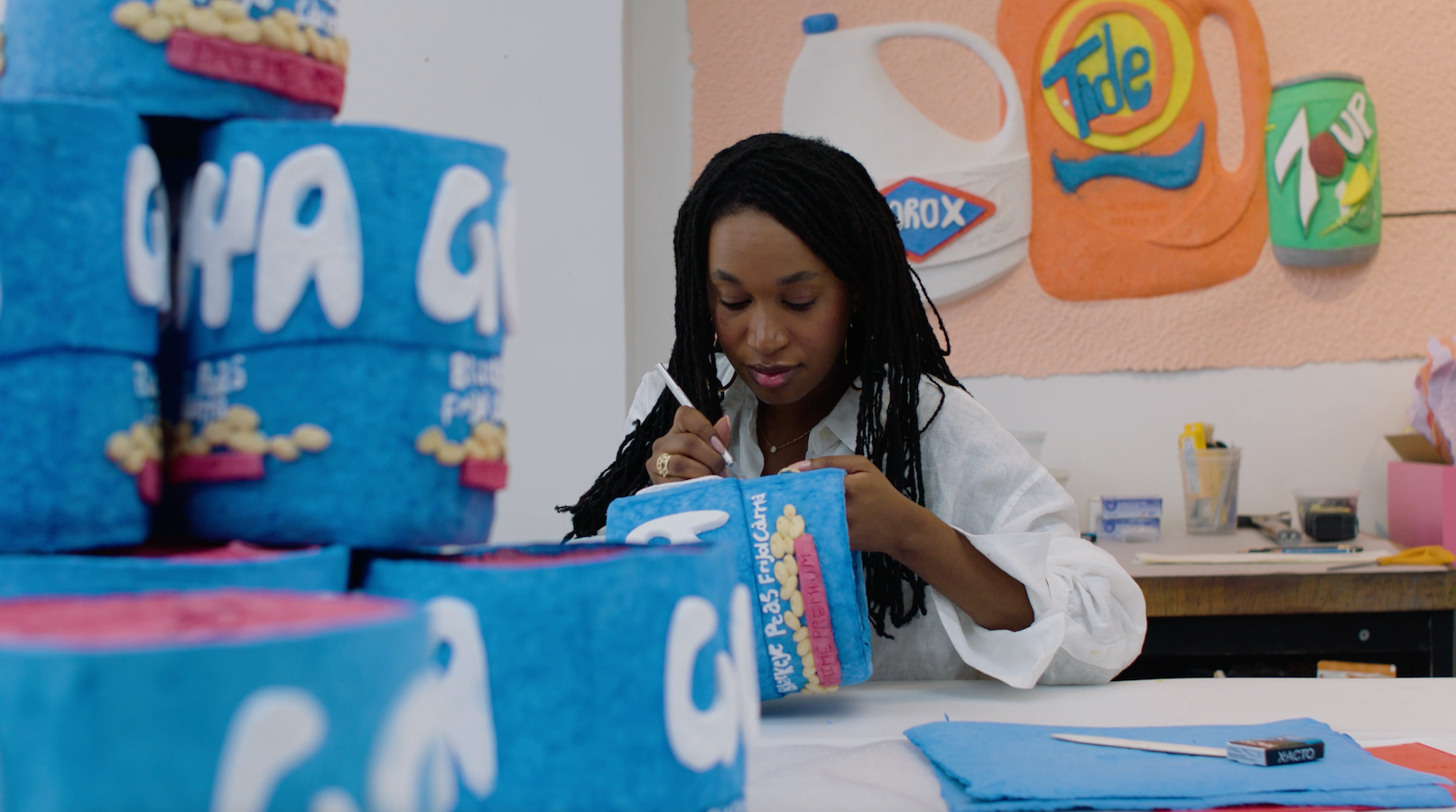
The New York Armory Show. The place to buy six-figure paintings, monumental sculptures… and a giant tower of cans of Goya black-eyed peas? That’s just one of the sculptural works available from Tschabalala Self in her installation Bodega Run with Two Palms, the New York City gallery and printmaking studio that specializes in pushing the boundaries of the medium.
The project is an ode to the ubiquitous New York bodega that Self, a Harlem native, has been exploring since 2017. There are colorful silkscreens of candy bars, soda, and other bodega junk food, as well as cast paper still lifes featuring Scott’s toilet paper, Fabuloso cleaner, and Negra Modelo beer, among other products.
It’s a celebration of the small, family-run corner store that sells just about everything, all hours of the day. But it’s also a reminder that bodegas are often one of the only kinds of business you find in lower-income neighborhoods. Self is interested in the social, political, and economic implications of the bodega, and where you find them.
“In New York, you see the difference as you go from neighborhood to neighborhood. Whatever stores or institutions are in your neighborhood are basically a reflection of what the society believes you deserve,” Self told me. “Growing up in Harlem in the ’90s, there were very few banks, many check cashing places, very few supermarkets, many, many bodegas.”
The bodega is one of the earliest places Self remembers being allowed to go by herself, and, as such, it was a fixture of her childhood. Likewise, many viewers feel a sense of nostalgia and joy when they see the work—what New Yorker doesn’t love a bodega?
“There’s so many things in Black and brown life that are born out of a difficult situation but that become things worth celebrating,” Self said, noting that bodegas have become important community spaces.
Tschabalala Self’s installation Bodega Run with Two Palms at the Armory Show. Photo courtesy of Two Palms.
The first version of Bodega Run was at Pilar Corrias in London in 2017, followed by an outing at the Hammer Museum in Los Angeles in 2019. A book, released earlier this year, was originally intended as the end to the project, accompanied by a three-day installation at New York’s Swiss Institute featuring many of the works made with Two Palms.
“But it was just so exciting to revisit the project,” Self said. “I’ve been getting a lot of new ideas, a lot of new inspirations. Exploring the project within the context of printmaking solely has this opened up to so many more ideas.”
Tschabalala Self photographing her installation Bodega Run with Two Palms at the Armory Show. Photo courtesy of the artist.
The artist began working with Two Palms over two years ago, first creating print versions of her Bodega Run drawings before branching out into more three-dimensional works made from cast paper. It was a medium Self was familiar with from working as an assistant to artist Leonardo Drew during college, and she soon abandoned the page entirely to work in the round.
“Two Palms has always been experimenting with making works that are really physical and that have depth,” gallery director Alexandra Slattery told me. “With Tschaba, we’ve been able to take that to a whole new level, and that’s extremely exciting for us.”
Tschabalala Self’s installation Bodega Run with Two Palms at the Armory Show. Photo courtesy of Two Palms.
Self’s project is the first time the gallery has shown an installation piece, with everything down to the vinyl wallpaper created for the occasion. Numerous works have already sold to what Slattery described as “really great major collections,” both public and private. (Prices top out at $125,000.)
If the Armory Show is, in fact, the final iteration of Bodega Run, it’s perhaps the perfect venue for it.
“The project is thinking about the hierarchies between different commercial spaces. What exactly is the difference between the gallery and the corner store?” Self said. “In reality, they both are commercial and transactional spaces.”
The Armory Show is on view at the Javits Center, 429 11th Avenue, New York, New York, September 5–8, 2024.